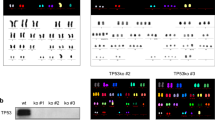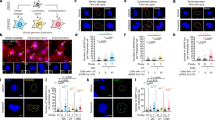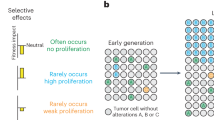Abstract
Most cancers have multiple chromosomal rearrangements; the molecular mechanisms that generate them remain largely unknown. Mice carrying a heterozygous missense change in one of the DNA-binding domains of Rpa1 develop lymphoid tumors, and their homozygous littermates succumb to early embryonic lethality. Array comparative genomic hybridization of the tumors identified large-scale chromosomal changes as well as segmental gains and losses. The Rpa1 mutation resulted in defects in DNA double-strand break repair and precipitated chromosomal breaks as well as aneuploidy in primary heterozygous mutant mouse embryonic fibroblasts. The equivalent mutation in yeast is hypomorphic and semidominant and enhanced the formation of gross chromosomal rearrangements in multiple genetic backgrounds. These results indicate that Rpa1 functions in DNA metabolism are essential for the maintenance of chromosomal stability and tumor suppression.
This is a preview of subscription content, access via your institution
Access options
Subscribe to this journal
Receive 12 print issues and online access
$209.00 per year
only $17.42 per issue
Buy this article
- Purchase on Springer Link
- Instant access to full article PDF
Prices may be subject to local taxes which are calculated during checkout



Similar content being viewed by others
References
Wold, M.S. Replication protein A: a heterotrimeric, single-stranded DNA-binding protein required for eukaryotic DNA metabolism. Annu. Rev. Biochem. 66, 61–92 (1997).
Chen, C., Umezu, K. & Kolodner, R.D. Chromosomal rearrangements occur in S. cerevisiae rfa1 mutator mutants due to mutagenic lesions processed by double-strand-break repair. Mol. Cell 2, 9–22 (1998).
Chen, C. & Kolodner, R.D. Gross chromosomal rearrangements in Saccharomyces cerevisiae replication and recombination defective mutants. Nat. Genet. 23, 81–85 (1999).
Soustelle, C., Vedel, M., Kolodner, R. & Nicolas, A. Replication protein A is required for meiotic recombination in Saccharomyces cerevisiae . Genetics 161, 535–547 (2002).
Kim, H.S. & Brill, S.J. Rfc4 interacts with Rpa1 and is required for both DNA replication and DNA damage checkpoints in Saccharomyces cerevisiae . Mol. Cell. Biol. 21, 3725–3737 (2001).
Lee, S.E. et al. Saccharomyces Ku70, mre11/rad50 and RPA proteins regulate adaptation to G2/M arrest after DNA damage. Cell 94, 399–409 (1998).
Zou, L. & Elledge, S.J. Sensing DNA damage through ATRIP recognition of RPA-ssDNA complexes. Science 300, 1542–1548 (2003).
Umezu, K., Sugawara, N., Chen, C., Haber, J.E. & Kolodner, R.D. Genetic analysis of yeast RPA1 reveals its multiple functions in DNA metabolism. Genetics 148, 989–1005 (1998).
Lim, D.S. & Hasty, P. A mutation in mouse rad51 results in an early embryonic lethal that is suppressed by a mutation in p53. Mol. Cell. Biol. 16, 7133–7143 (1996).
Tsuzuki, T. et al. Targeted disruption of the Rad51 gene leads to lethality in embryonic mice. Proc. Natl. Acad. Sci. USA 93, 6236–6240 (1996).
Symington, L.S. Role of RAD52 epistasis group genes in homologous recombination and double-strand break repair. Microbiol. Mol. Biol. Rev. 66, 630–670 (2002).
Cory, S., Vaux, D.L., Strasser, A., Harris, A.W. & Adams, J.M. Insights from Bcl-2 and Myc: malignancy involves abrogation of apoptosis as well as sustained proliferation. Cancer Res. 59 Suppl, 1685s–1692s (1999).
Karlsson, A. et al. Defective double-strand DNA break repair and chromosomal translocations by MYC overexpression. Proc. Natl. Acad. Sci. USA 100, 9974–9979 (2003).
Metz, T., Harris, A.W. & Adams, J.M. Absence of p53 allows direct immortalization of hematopoietic cells by the myc and raf oncogenes. Cell 82, 29–36 (1995).
van Gent, D.C., Hoeijmakers, J.H. & Kanaar, R. Chromosomal stability and the DNA double-stranded break connection. Nat. Rev. Genet. 2, 196–206 (2001).
Flores-Rozas, H. & Kolodner, R.D. Links between replication, recombination and genome instability in eukaryotes. Trends Biochem. Sci. 25, 196–200 (2000).
Debrauwere, H., Loeillet, S., Lin, W., Lopes, J. & Nicolas, A. Links between replication and recombination in Saccharomyces cerevisiae: a hypersensitive requirement for homologous recombination in the absence of Rad27 activity. Proc. Natl. Acad. Sci. USA 98, 8263–8269 (2001).
Myung, K. & Kolodner, R.D. Suppression of genome instability by redundant S-phase checkpoint pathways in Saccharomyces cerevisiae . Proc. Natl. Acad. Sci. USA 99, 4500–4507 (2002).
Myung, K., Datta, A. & Kolodner, R.D. Suppression of spontaneous chromosomal rearrangements by S phase checkpoint functions in Saccharomyces cerevisiae . Cell 104, 397–408 (2001).
Pennaneach, V. & Kolodner, R.D. Recombination and the Tel1 and Mec1 checkpoints differentially effect genome rearrangements driven by telomere dysfunction in yeast. Nat. Genet. 36, 612–617 (2004).
Myung, K., Chen, C. & Kolodner, R.D. Multiple pathways cooperate in the suppression of genome instability in Saccharomyces cerevisiae . Nature 411, 1073–1076 (2001).
Klein, H.L. Spontaneous chromosome loss in Saccharomyces cerevisiae is suppressed by DNA damage checkpoint functions. Genetics 159, 1501–1509 (2001).
Umbricht, C.B. et al. High-resolution genomic mapping of the three human replication protein A genes (RPA1, RPA2, and RPA3). Genomics 20, 249–257 (1994).
Mackay, J., Steel, C.M., Elder, P.A., Forrest, A.P. & Evans, H.J. Allele loss on short arm of chromosome 17 in breast cancers. Lancet 2, 1384–1385 (1988).
Baker, S.J. et al. Chromosome 17 deletions and p53 gene mutations in colorectal carcinomas. Science 244, 217–221 (1989).
Devilee, P. et al. At least four different chromosomal regions are involved in loss of heterozygosity in human breast carcinoma. Genomics 5, 554–560 (1989).
Coles, C. et al. Evidence implicating at least two genes on chromosome 17p in breast carcinogenesis. Lancet 336, 761–763 (1990).
Chen, L.C. et al. Loss of heterozygosity on the short arm of chromosome 17 is associated with high proliferative capacity and DNA aneuploidy in primary human breast cancer. Proc. Natl. Acad. Sci. USA 88, 3847–3851 (1991).
Tharapel, S.A. & Kadandale, J.S. Primed in situ labeling (PRINS) for evaluation of gene deletions in cancer. Am. J. Med. Genet. 107, 123–126 (2002).
Christianson, T.W., Sikorski, R.S., Dante, M., Shero, J.H. & Hieter, P. Multifunctional yeast high-copy-number shuttle vectors. Gene 110, 119–122 (1992).
Acknowledgements
We thank H. Hou, Jr. and B. Jin for technical assistance and S. Brill for providing antibodies. This work was supported by grants from the US National Institutes of Health (to R.K., R.D.K. and W.E.).
Author information
Authors and Affiliations
Corresponding authors
Ethics declarations
Competing interests
The authors declare no competing financial interests.
Supplementary information
Supplementary Fig. 1
Molecular dynamics suggests that the L221P mutation disrupts the DNA-binding interface of the oligonucleotide binding (OB) domain 1 of human RPA1. (PDF 5784 kb)
Supplementary Fig. 2
Laser capture microdissection (LCM) and loss of heterozygosity (LOH) analysis. (PDF 379 kb)
Supplementary Fig. 3
Partial dominance of plasmid borne rfa1-L221P alleles for sensitivity to constitutive expression of HO endonuclease. (PDF 7308 kb)
Supplementary Table 1
Summary of chromosomal aberrations in lymphomas of Rpa1L230P/+ mice. (PDF 60 kb)
Supplementary Table 2
Karyotypic aberrations in Rpa1L230P/+ MEFs. (PDF 51 kb)
Supplementary Table 3
Partial dominance of plasmid-borne rfa1-L221P alleles in MMS sensitivity. (PDF 64 kb)
Supplementary Table 4
Partial dominance of plasmid-borne rfa1-L221P alleles in HU sensitivity. (PDF 65 kb)
Supplementary Table 5
Partial dominance of plasmid-borne rfa1-L221P alleles in UV sensitivity. (PDF 719 kb)
Rights and permissions
About this article
Cite this article
Wang, Y., Putnam, C., Kane, M. et al. Mutation in Rpa1 results in defective DNA double-strand break repair, chromosomal instability and cancer in mice. Nat Genet 37, 750–755 (2005). https://doi.org/10.1038/ng1587
Received:
Accepted:
Published:
Issue Date:
DOI: https://doi.org/10.1038/ng1587
This article is cited by
-
Unravelling the clinicopathological and functional significance of replication protein A (RPA) heterotrimeric complex in breast cancers
npj Breast Cancer (2023)
-
LAP2α preserves genome integrity through assisting RPA deposition on damaged chromatin
Genome Biology (2022)
-
WASp modulates RPA function on single-stranded DNA in response to replication stress and DNA damage
Nature Communications (2022)
-
Interaction Between Essential (Zn) and Toxic (Cd) Elements in Different Stages of Female Breast Cancer Patients, Resident in Different Cities of Sindh, Pakistan
Biological Trace Element Research (2022)
-
Depletion of NK6 Homeobox 3 (NKX6.3) causes gastric carcinogenesis through copy number alterations by inducing impairment of DNA replication and repair regulation
Oncogenesis (2021)



